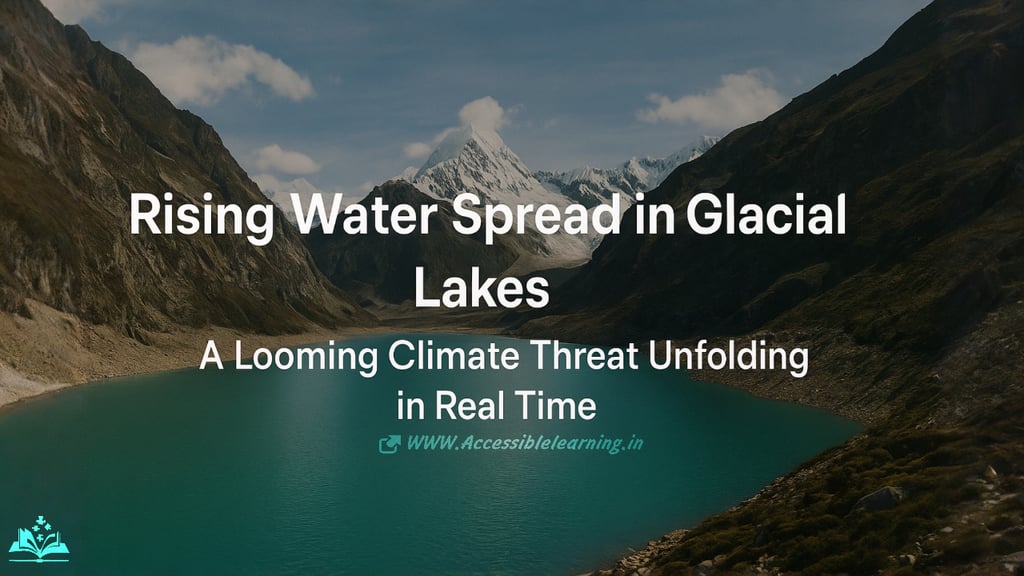
Rising Water Spread in Glacial Lakes: A Looming Climate Threat Unfolding in Real Time
Discover the alarming rise in glacial lake water spread due to climate change. This detailed, human-centered article explores the science behind glacial lake expansion, its global hotspots, catastrophic flood risks (GLOFs), and what must be done to monitor, manage, and adapt to this growing climate threat.
NEWS/CURRENT AFFAIRSDARK SIDEENVIRONMENTEUROPEAN POLITICS
Keshav Jha
7/19/20253 min read


Rising Water Spread in Glacial Lakes: A Global Wake-Up Call
As the Earth continues to heat up, the world's glaciers are melting at unprecedented rates. While this signals the retreat of ice, it also marks the silent expansion of glacial lakes—bodies of water formed from meltwater pooling at the foot of glaciers. Over the past few decades, these lakes have been growing both in size and number, a clear indicator of the accelerating pace of climate change.
But more than just signs of global warming, these rising glacial lakes represent serious risks to downstream communities, ecosystems, and infrastructure. In this article, we delve into the causes, consequences, and global significance of the expanding water spread in glacial lakes.
What Are Glacial Lakes?
Glacial lakes form when glaciers melt and the water becomes trapped in depressions or behind natural dams of ice or moraines (accumulations of glacial debris). These lakes can range from small seasonal ponds to vast water bodies spanning kilometers.
Key Types of Glacial Lakes
Proglacial Lakes: Found at the front of glaciers.
Supraglacial Lakes: Sit atop a glacier.
Subglacial Lakes: Hidden underneath ice sheets.
Ice-dammed or Moraine-dammed Lakes: Held back by glacial moraines or ice walls.
The Rising Trend: What the Data Tells Us
According to a 2020 global satellite analysis published in Nature Climate Change, glacial lakes have expanded by more than 50% in volume since 1990. The most significant changes are seen in:
The Himalayas
The Andes
The Alps
Alaska and the Canadian Rockies
Patagonia
In some cases, entire valleys that were once dry or glaciated are now submerged in meltwater.
Causes Behind the Rising Spread
Global Warming
Rising atmospheric temperatures directly accelerate glacier retreat and increase meltwater runoff, forming larger lakes.
Black Carbon & Soot
Particles from industrial emissions and forest fires settle on glaciers, absorbing heat and intensifying melting.
Permafrost Thawing
Frozen ground beneath glaciers is melting, destabilizing the surrounding land and creating basins for water to collect.
Changes in Precipitation
Altered rainfall and snow patterns in mountainous regions are adding more liquid water to glacial systems.
The Consequences: Why It Matters
Glacial Lake Outburst Floods (GLOFs)
Possibly the most terrifying consequence. When a glacial lake overflows or its dam fails (due to landslides, earthquakes, or ice avalanches), the result is a catastrophic flood. These GLOFs can destroy entire villages in minutes.
Case in point: In 2013, Uttarakhand (India) experienced devastating floods linked to glacial lake overflow, resulting in over 5,000 deaths.
Loss of Freshwater Resources
Glaciers act as natural water reservoirs. As they shrink, long-term freshwater supply for agriculture and drinking diminishes.
Threats to Biodiversity
Changing water systems disrupt local flora and fauna. Cold-adapted species are especially vulnerable to shifting ecosystems.
Infrastructure Damage
Roads, hydropower plants, bridges, and settlements built downstream face increased risks from unstable glacial systems.




Monitoring & Solutions
Remote Sensing & Satellite Monitoring
Space agencies like NASA and ESA are tracking lake growth with satellites like Landsat and Sentinel.
Early Warning Systems
Nepal, India, and Bhutan are developing GLOF early-warning systems using automated sensors, river gauges, and SMS alerts.
Engineering Interventions
Controlled drainage of lakes
Construction of artificial barriers
Reinforcement of natural dams
Community-Based Adaptation
Involving locals in risk assessment and evacuation plans improves resilience and awareness.
What Lies Ahead?
Climate models suggest that glacier loss will continue even if emissions stop today—a concept known as "committed melting." That means glacial lakes will continue to expand for at least the next few decades.
While nature adjusts, humans must act. Adaptation and mitigation strategies need urgent scaling, especially in vulnerable high-altitude regions where millions depend on glacial water.
The spread of glacial lake water isn’t just a remote mountain issue. It’s a powerful reflection of our changing climate, with ripple effects that touch agriculture, migration, and global water security. Addressing this silent crisis demands science, policy, community engagement, and, most critically, urgent climate action.
FAQs
Q. What causes glacial lakes to grow?
Glacial lakes grow primarily due to rising global temperatures that cause glaciers to melt, forming and enlarging lakes in glacier-carved basins.
Q. What is a Glacial Lake Outburst Flood (GLOF)?
GLOF is a sudden release of water from a glacial lake, typically triggered by dam failure, landslides, or ice collapses, leading to devastating downstream flooding.
Q. Which countries are most at risk?
Countries in the Himalayas (Nepal, Bhutan, and India), parts of South America (Peru and Chile), and the Alps are among the most vulnerable to glacial lake-related disasters.
Q. Can glacial lake floods be prevented?
While natural disasters can't be entirely prevented, risks can be minimized using early-warning systems, lake drainage projects, and structural reinforcements.
Q. Is this linked directly to climate change?
Yes. The expansion of glacial lakes is a direct and visible impact of global warming and is backed by decades of climate data and research.
Subscribe to our newsletter
All © Copyright reserved by Accessible-Learning
| Terms & Conditions
Knowledge is power. Learn with Us. 📚


